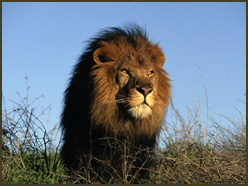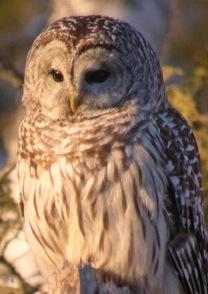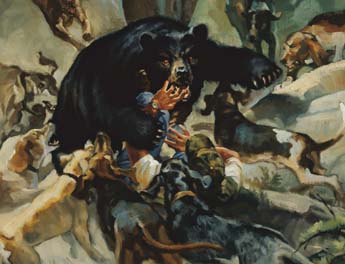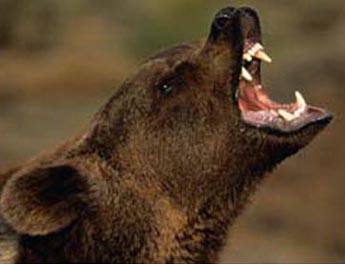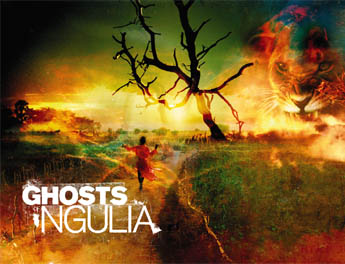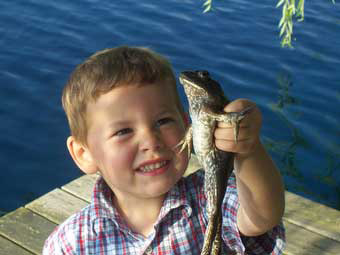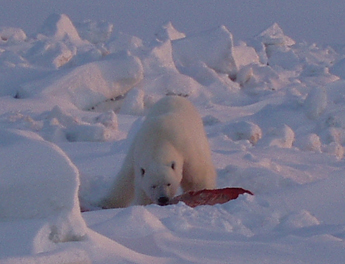The hickory tree was 60 feet tall, its stout branches laden with fall foliage. From a distance, I watched a squirrel run up its trunk; then I eased closer. Despite intense glassing with a binocular, I couldn’t see the animal. Unless it had jumped into the canopy of a neighboring tree, I knew it still had to be there. I sat on the forest floor where I could see up into the branches and made myself comfortable.
Moments later a shard of hickory hull fell out of the tree, hitting the ground a few feet away. Another followed, and soon it was raining nut bits. I noted that the falling chips made a distinct sound as they struck the ground. Then I heard another noise from high in the tree. I could actually hear the squirrel cutting the nuts.
By looking up at the source of the falling shells, I pinpointed the squirrel’s location, but I still couldn’t see it. Then I saw movement and spotted its tail. A few moments later it moved enough for me to see its head and chest. My .22 cracked and the squirrel was mine.
That intense listening exercise taught me something I had never really appreciated: It’s possible to locate game by being alert to the slightest sounds. I slipped through the woods the rest of the afternoon, testing my newfound technique. By the end of the day I’d collected my limit of bushytails–all but one simply by listening hard.
Even though that hunt occurred many decades ago, I learned a lesson I’ve never forgotten: The sense of hearing is as important as sight, perhaps more so. To see an animal, it must be at the right place or show enough of its form to be identified. To hear an animal, you don’t need visual contact. You just have to be within earshot.
You can’t learn to listen from a textbook. It must be experienced first-hand. For this to happen, you must pay more than casual attention to what you hear. Make a mental note of the sound; then recreate it in your mind.
Many years ago, I heard a subtle and strange scraping sound while hunting deer during an early September season in Colorado. I was new to Western big game at the time, and had no idea what was making the noise. I slipped toward it and saw a bull elk vigorously rubbing a sapling with his antlers. When I approached to a point where I had visual contact, I could see the tree shaking, but it was the sound that drew me toward it first.
Recently I was hunting turkeys in Texas. I took a midday break to fish for catfish in a small pond. The ranch manager was loafing around with me, and suddenly I heard a tiny shrill squeal. “A snake’s got a frog,” drawled my companion, without taking a look. “It’s a nasty world out there.”
Intrigued, I got up from my comfortable seat and walked to the sound. There was indeed a snake with a frog in its mouth.
Sometimes animal sounds are distinctly different from normal. Once, when hunting turkeys during a strong blow, I heard a gobbler that sounded like he was half a mile away. At least, I thought it was a gobble, since I couldn’t hear all of it, just parts of it. I continued to call, and I kept hearing the strange response. Ten minutes later I saw the tom slowly working toward me. Before I shot him, his last gobble was 35 yards away. I barely heard it.
Any sound you hear in the woods should be treated with suspicion. Try to analyze what made it and how it was made. I was rattling whitetails in Texas with my hunting buddy Gary Roberson when I heard the distinct sound of something striking a nearby barbed-wire fence. It was a slight strumming sound. Roberson and I turned slowly to see a buck staring at us from along the fenceline. The deer had jumped it and his hoof had hit the top wire as he sailed over. That muffled metallic sound was all we had heard.
Another time I was sitting in a glade, watching a thick patch of pines and firs for an elk. It was public land, plenty of hunters were about, and I was hoping someone would push an elk to me. Suddenly I heard something strike a log in the woods. That was it; nothing else. It sounded like a hoof hitting wood. Then, several yards away, I heard a similar sound. Whatever was making it was moving within the timber where I couldn’t see, and moving fast. I ran along the small ridge I was sitting on and had gained a hundred yards when a bull and four cows burst out of the trees. I claimed the bull, which I never would have seen from my original spot. Luckily I had interpreted those sounds correctly.
While I was hunting bears with outfitter Ron Alexander in Manitoba, he tapped me on the shoulder and whispered that a bear was coming. Ron saw my puzzled look and simply said, “Geese.” Then I realized what he meant. Moments before, several geese had lifted from a nearby pond, honking incessantly. A bear had evidently spooked the geese. A few moments later the bruin showed up.
Various wildlife species can provide valuable clues to other animals’ movements. Jays, magpies, ravens, squirrels and others may be trying to tell you that a trophy buck is near.
The sounds you make must be considered too. Remember this: The snap of a twig is quickly forgotten by the hunter, but is long remembered by the animal being hunted.
I firmly believe that a hunter who listens well, interprets sounds correctly and reacts appropriately will have a far better chance of scoring than the person who blunders through the woods, oblivious to the sounds that scream for attention.

